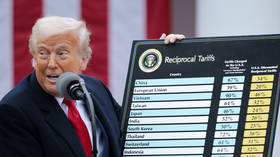Almost a THIRD of US workers can’t live on their paychecks, spelling doom for a service economy based on discretionary spending
Almost one in three American workers can’t quite make ends meet in between paydays, a new survey has revealed. This doesn’t bode well for the US’ service economy, where discretionary spending is the major driver of growth.
Some 32 percent of US workers are unable to stretch their salaries to cover their needs, according to a survey published on Tuesday by Salary Finance. Nor is this inability to make one’s paycheck last limited to poor and working-class individuals - the poll queried over 2,700 adults working for medium- to large-sized companies about their finances and found that even among those making over $200,000 annually, 32 percent “always” or “most of the time” ran out of cash before payday.
Also on rt.com Dem primary chaos: Millionaire actress roasted for stopping crowd from booing Hillary & whining about living on ‘crumbs’Certainly, the insufficient-funds problem is more severe for those making under $15,000 per year - fully 40 percent, or two in five, are unable to make ends meet on that salary. But no matter how high up the pay scale one goes, the problem stubbornly refuses to vanish.
When “living paycheck to paycheck” - once the hallmark of the stressed-out working poor - becomes an aspirational goal, it’s clear the US economy is in trouble. But this isn’t a bolt out of the blue: a 2019 survey found 78 percent of American workers were living paycheck-to-paycheck , and similar scary figures have graced financial headlines for years.
How, then, might Americans square the slow collapse into poverty they see in themselves and their neighbors with the vision of golden prosperity laid out by President Donald Trump at the State of the Union earlier this month, bolstered by facts and figures that surely no one could refute? It’s common knowledge that as cost of living has increased in the last half-century, American wages have stagnated. But the reality is actually getting worse - since 2006, median wages have actually declined 9 percent when adjusted for inflation, according to the PayScale Index . While Trump may praise the country’s swelling employment numbers to the sky, many of those are gig-economy positions that offer no benefits or real job security and don’t come close to replacing the long-term career-oriented jobs wiped out in the financial crash of 2008.
Also on rt.com That’s a bit rich: Biden says paycheck doesn’t matter, jobs are ‘about dignity’At the same time as workers make hardly more (or even less) than they did 40 years ago, average consumer prices keep on creeping up, increasing 2.3 percent in the last year alone, according to the Bureau of Labor Statistics Healthcare costs increased by more than twice that rate. But Americans keep consuming at the same rate they have all their lives, accustomed to a certain standard of living. Shopping is second-nature to those raised in the service economy of the post-NAFTA years, taught to express themselves in their purchases. It is this cultivated need to consume as a core function of their humanity that has kept that economy alive, fed on discretionary dollars. This is not irresponsible or frivolous spending, either - a nation of perpetual customers who can be counted on to spend their surplus income on products they don’t necessarily need but have been told they want and deserve has been absolutely critical to keeping the economic engines running.
And when those customers run out of surplus income? They’re already out, for one thing - nearly half (48 percent) of respondents to the Salary Finance survey admitted they don’t have any money set aside, even for emergencies. Consumer credit card debt hit a record $930 billion earlier this week, dwarfing the numbers seen during the 2008 crisis. Even before taking into account student debt - a crisis in itself - and mortgage debt approaching 2008 levels, the American consumer, once liberated by the ability to buy anything they wanted, is now weighed down by the hangover from a decade-long shopping spree.
This is uncharted territory. The only certainty is that business as usual - debt bubbles swollen beyond absurdity while the supposed adults in the room are literally swimming in too much money to care - can’t last forever.
Think your friends would be interested? Share this story!
The statements, views and opinions expressed in this column are solely those of the author and do not necessarily represent those of RT.
















